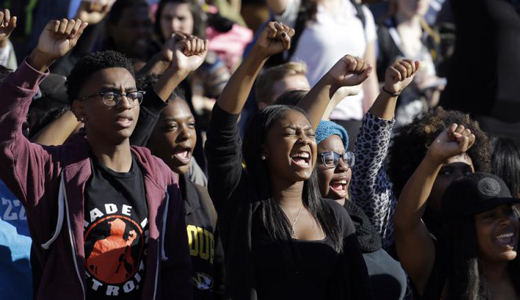
Near the beginning of April at the University of Illinois at Urbana-Champaign, students found themselves facing an onslaught of racially targeted hate speech throughout campus. It began with a series of disturbing events: first, on April 5th, anti-immigrant, pro-Trump messages appeared, chalked out on the sidewalk in front of the Latino/a Studies Department. Statements such as “They have to go back #Trump” and “Build a Wall” caused shock and outrage among the campus Latinx community.
The university, however, said that the comments were protected under “freedom of speech” and that they encouraged political discourse. That same week, a letter from Interim Provost Edward Feser and Vice Chancellor for Student Affairs Renee Romano was issued. The letter stated: “The best recourse to speech with which we disagree is more speech: Speech that clearly articulates a stronger and better argued point of view. Speech that represents the values we hold most dear. Speech that builds connections and shared understanding.” Ironically, this sentiment came from the same collective of administrators that fired Steven Salaita in August of 2014, the Palestinian-American professor who was promised a position at UIUC, until he tweeted criticisms of the Israeli government that some perceived as anti-Semitic comments. The Salaita case raises serious questions as to how school administrators determine the type of “valued” discourse” that is recognized and protected by the First Amendment on college campuses.
Rhetoric can cause harm
These aren’t trivial issues. One could argue that the administration’s apathy towards the type of clear discriminatory rhetoric shown in the chalked messages at UIUC opened the floodgates to the events that followed; anti-feminist chalk in front of the Women’s Resource Center, the creation of several anti-black Facebook groups that targeted black student activists, and eventually the spray painting of swastikas on buildings across campus. All these acts took place before the end of the spring semester. By the time the administration decided to follow up April 29 with a second letter “condemning” the actions, much damage had been done.
There is no question that racism has evolved and shifted since the days of legal slavery, repackaging itself into a much more modern structural shape. While it still occasionally manifests blatantly, as it did on the Illinois campus, we no longer regularly witness the level of large-scale, overt segregation that once was. Students, however, now cope with implicit undertones of bigotry from their classmates that are expressed in all sorts of subtle ways. Because of this subtlety, there are some that would claim that Millennials are a generation of entitled and “over sensitive whiners,” that resort to the need for safe spaces to escape the reality of real world obstacles.
The media in particular has made it a point to express its outrage at being excluded from what activists refer to as ‘safe spaces.’ A safe space, according to the Wikipedia definition, implies a “certain license to speak and act freely, form collective strength, and generate strategies for resistance. It is a means rather than an end and not only a physical space but also a space created by the coming together of [individuals] searching for community.” The original concept stemmed from the Women’s Liberation Movement of the late 1960s and early 70s. The first physical safe spaces were largely influenced by the LGBTQ community and the Queer bar scene. Since then, safe spaces have become a powerful tool for mobilization and a place of refuge for marginalized people.
Late last year the media invaded Mizzou’s [University of Missouri’s nickname] campus following a slew of racist incidents that led to the eventual resignation of then-University President Tim Wolfe. It was reported that several journalists were, sometimes aggressively, forced out of designated ‘safe areas’ set up by students. Many activists have tense relationships with existing news outlets, as mainstream media has spent years demonizing the righteous, but sometimes unruly, demonstrations that characterize social justice movements. Protesters often see their words taken out of context, or images used against them, and many would rather avoid conversing with media all together. This led to quite a number of outlets voicing outrage and disapproval, with platforms, such as The Atlantic, publishing articles on the “weaponization” of safe spaces. Some even went so far as to accuse activists of hindering the progressive movements through censorship. But without some restrictions on hate speech on campus, or refuge for those who are its targets, things can escalate quickly.
Both concepts have leftist roots
The ‘free speech’ vs. ‘safe space’ binary is where the lines get blurry. There is an underlying assumption that neither can thrive while the other survives – but the origins of both stem from movements for social justice and against capitalism. When examining the long history of free speech in the United States, it becomes apparent that a number of restrictive censorship legislations were specifically constructed to hinder radical movements. The Sedition Act of 1918 targeted anarchists, socialists, and other left-wing activists who opposed U.S. participation in World War I. It made it a crime to “willfully utter, print, write, or publish any disloyal, profane, scurrilous, or abusive language about the form of the Government of the United States” or to “willfully urge, incite, or advocate any curtailment of the production” of the things “necessary or essential to the prosecution of the war.”
Similarly, the Alien Registration Act of 1940 (Smith Act), made it illegal for anyone in the United States to advocate, abet, or teach the desirability of overthrowing the government. It was strategically enacted as an excuse to indict 215 people who were alleged communists, anarchists, and fascists. The Smith Act also helped to build the hysteria around the Red Scare. Given the fact that encroachments on free speech have historically targeted the left, it is understandable why even progressives today find themselves eager to denounce any method of ‘censorship.’
As a reporter, the critical relevance of free speech is not something I take lightly. However, as a Queer, disabled, Latinx, womyn who has had to navigate predominantly white institutions for most of her life, I also hold the value of safe spaces in the utmost regard. During my undergraduate years, I spent a majority of my time studying at “La Casa,” the Latino cultural center on my campus. Though the center was created as a place of refuge for many Latinx students, it also held a rich history of struggle . La Casa was founded in 1970 by Latinx students and faculty who protested for the right to have a sanctuary that they could call their own. The cultural center was a result of demonstrations and conflict with administrators on campus who did not understand the necessity of creating these spaces for students of color.
During my time in undergraduate school, I witnessed professors openly use alienating terms such as “illegals,” and encountered numerous students who have donned black face at costume parties. I repeatedly saw brown men profiled by the campus police and spoke to women who were sexually assaulted by trusted friends. At the end of the day there was one place where I knew, without hesitation, that I could escape to with my frustrations and tears: La Casa.
Northwestern University’s President, Morton Schapiro, wrote a controversial open letter addressing the topic recently, stating that everyone deserved a safe space. It was a response to an incident where black students declined to extend an invite to white students who wanted to join a discussion they were having at the NU cafeteria. “Those black students had every right to enjoy their lunches in peace. There are plenty of times and places to engage in uncomfortable learning, but that wasn’t one of them. The white students, while well-meaning, didn’t have the right to unilaterally decide when uncomfortable learning would take place.” The idea that people of color must foster environments of ‘open dialogue’ at all times and appease to the needs of their white peers is an extension of a post-colonial mindset. It is not simply a call for civil discourse, but a demand that any marginalized individual be able to decouple themselves from their personal experiences so as to better educate the public. It is a process that requires people of color not only to politicize, or render abstract, their personalized identity, but then be accountable for-or take care of- the feelings of their white peers. It is a conversation that, unless navigated with exact precision, leads to further validate the existence of white supremacist power structures.
CNN News Anchor Don Lemon once said of the matter: “If you’re afraid of having your feelings hurt, don’t leave your house.” What Lemon vocalized is an echo of the common argument against safe spaces as representing a denial of the real world. It fails to acknowledge, however, the problematic message surrounding this statement; the notion that students can only escape the animosity and bigotry of the world by locking themselves away. After all, when a person gets robbed, society does not expect them never to go out again, we hold each other accountable for catching the thief. Similarly, Lemon shifts the blame from a racist or homophobic system back to the victims of systemic racism and oppression. This takes away the critical component of accountability, focusing attention on the behavior of marginalized students, instead of addressing what social constructs and pressures have led them to require safe sanctuaries.
Campuses should foster refuge and openness
While some have argued for the importance of preserving free speech over safe spaces, both derive from a shared fight against discrimination and right wing extremism. They were meant to grow side by side, but have since been pitched against one another and misconstrued to allow room for hate speech. Despite the ongoing struggle to make room for both civil discourse and safe spaces, students continue to navigate the grey areas of ‘free” and open dialogue. One thing remains clear however, so long as acts of bigotry continue to unfold across college campuses around the country, institutions have a duty to provide the asylum that marginalized youth require to survive.
The time I spent at La Casa was only one example of the way in which a life can be drastically shaped by an environment that provides both nurture and refuge. Student activists around the globe have shown that organizations such as BYP 100, Assata’s Daughters, Black and Pink, and others have utilized safe spaces as a means for progressive action. Now we, as citizens, must continue to challenge the problematic constructs in society that have driven young activists to seek sanctuary, and furthermore, provide them with the room to create their own revolutionary movements.
Photo: Students cheer while listening to protesters, following the announcement that Tim Wolfe, the president of the University of Missouri System, would resign for responding poorly to campus racism. Jeff Roberson | AP










